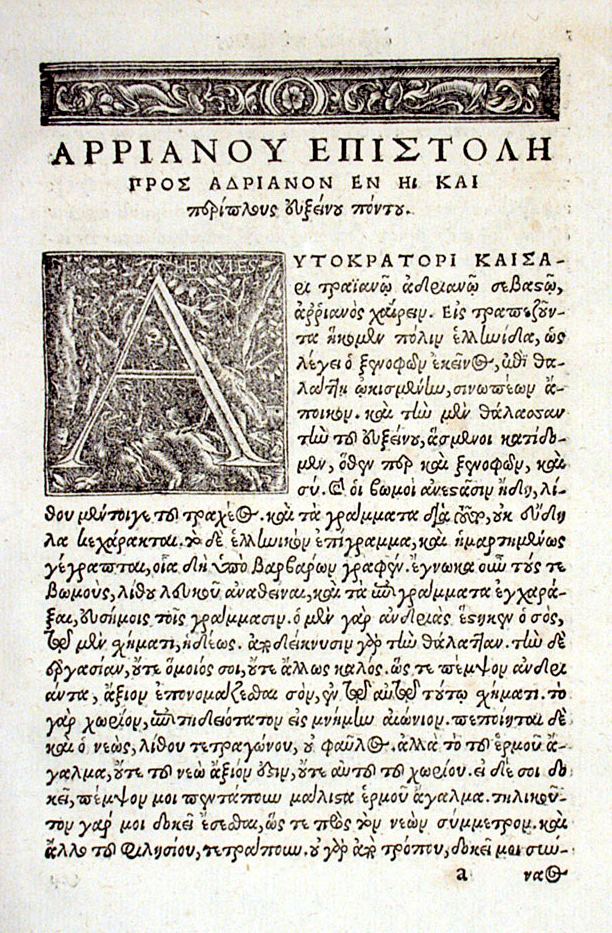A periplus (/ˈpɛrɪplʌs/) is a manuscript document that lists the ports and coastal landmarks, in order and with approximate intervening distances, that the captain of a vessel could expect to find along a shore. It served the same purpose as the later Roman itinerarium of road stops; however, the Greek navigators added various notes, which if they were professional geographers (as many were) became part of their own additions to Greek geography. In that sense the periplus was a type of log.
The form of the periplus is at least as old as the earliest Greek historian, the Ionian Hecataeus of Miletus. The works of Herodotus and Thucydides contain passages that appear to have been based on peripli.
Periplus is the Latinization of the Greek word περίπλους (periplous, contracted from περίπλοος periploos), is "a sailing-around." Both segments, peri- and -plous, were independently productive: the ancient Greek speaker understood the word in its literal sense; however, it developed a few specialized meanings, one of which became a standard term in the ancient navigation of Phoenicians, Greeks, and Romans.
Several examples of peripli that are known to scholars:
The Periplus of Himilco the Navigator, parts which are preserved in Pliny the Elder and Avienus.The Periplus of Hanno the Navigator, Carthaginian colonist and explorer who explored the coast of Africa from present-day Morocco southward at least as far as Senegal in the sixth or fifth century BCE.The Periplus of Scylax of Caryanda who allegedly sailed down the Indus River and then to Suez on the initiative of Darius I. This voyage is mentioned by Herodotus, and his pleriplus is quoted by Hecataeus of Miletus, Aristotle, Strabo and Avienus.The Massaliote Periplus, a description of trade routes along the coasts of Atlantic Europe, possibly dates to the sixth century BCE, also preserved in AvieniusPytheas of Massilia, (fourth century BCE) On the Ocean (Περί του Ωκεανού), has not survived; only excerpts remain, quoted or paraphrased by later authors, including Strabo, Diodorus Siculus, Pliny the Elder and in Avienus' Ora maritima.The Periplus of Pseudo-Scylax, generally is thought to date to the fourth or third century BCE.The Pleriplus of Nearchus surveyed the area between the Indus and the Persian Gulf under orders from Alexander the Great. He was a source for Strabo and Arrian, among others.On the Red Sea by Agatharchides. Fragments preserved in Diodorus Siculus and Photius.The Periplus of Scymnus of Chios is dated to around 110 BCE.The Periplus of the Erythraean Sea or Red Sea, was written by a Romanized Alexandrian in the first century CE. It provides a shoreline itinerary of the Red (Erythraean) Sea, starting at the port of Berenice. Beyond the Red Sea, the manuscript describes the coast of India as far as the Ganges River and the east coast of Africa (called Azania). The unknown author of the Periplus of the Erythraean Sea claims that Hippalus, a mariner, was knowledgeable about the "monsoon winds" that shorten the round-trip from India to the Red Sea. Also according to the manuscript, the Horn of Africa was called, "the Cape of Spices," and modern day Yemen was known as the "Frankincense Country." The Periplus Ponti Euxini, a description of trade routes along the coasts of the Black Sea, written by Arrian in the early second century CE.Persian sailors had from very old times their own sailing guide books which were called Rahnāmag in Middle Persian (later Rahnāmeh رهنامه in Persian).
A Rahnameh listed the ports and coastal landmarks and distances along the shores.
These lost but much-cited sailing directions go back at least until the 12th century. In some, the Indian Ocean was described as "a hard sea to get out of" and warned of the "circumambient sea, whence all return was impossible.
A periplus was also an ancient naval manoeuvre in which attacking triremes would outflank or encircle the defenders to attack them in the rear.

